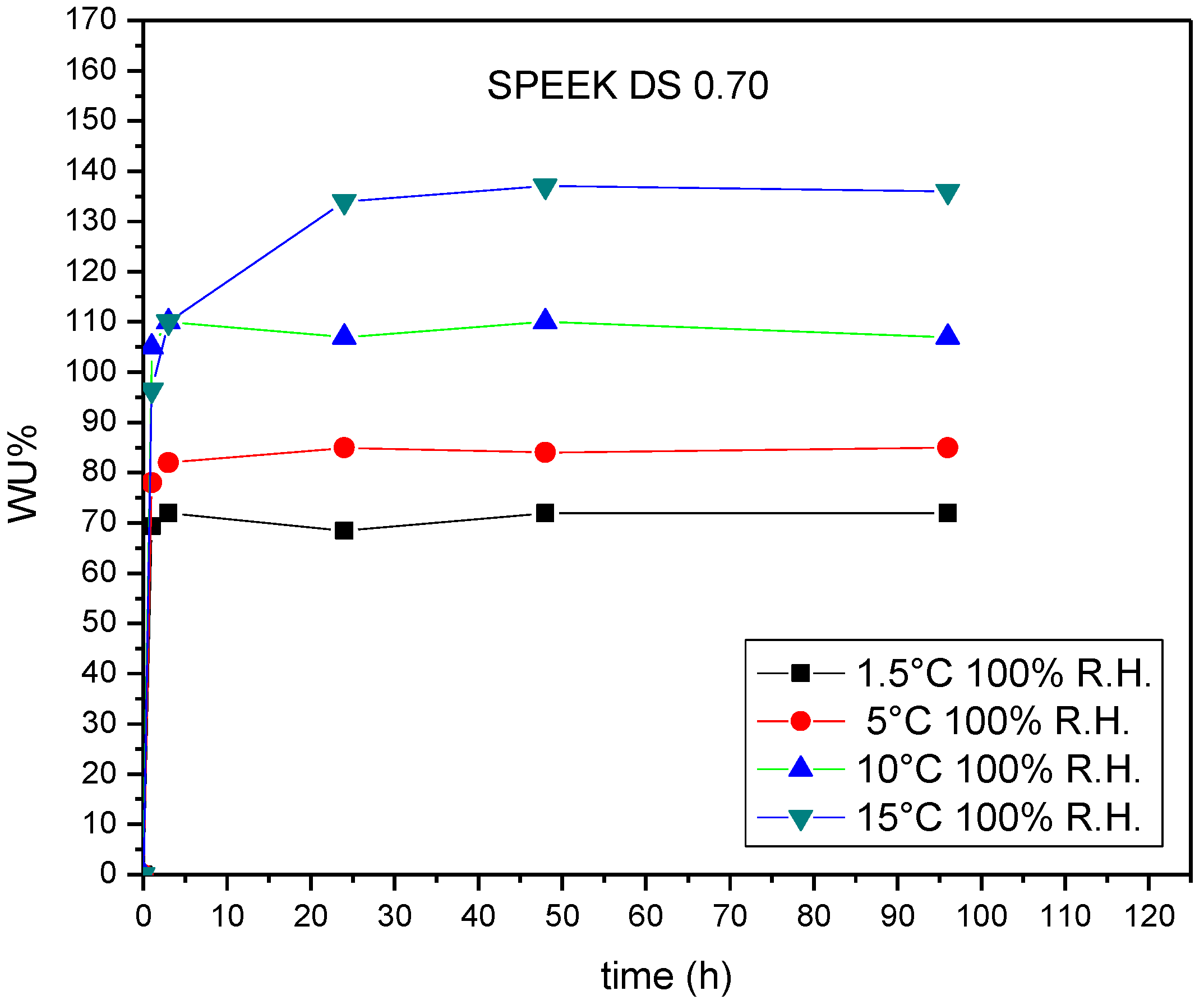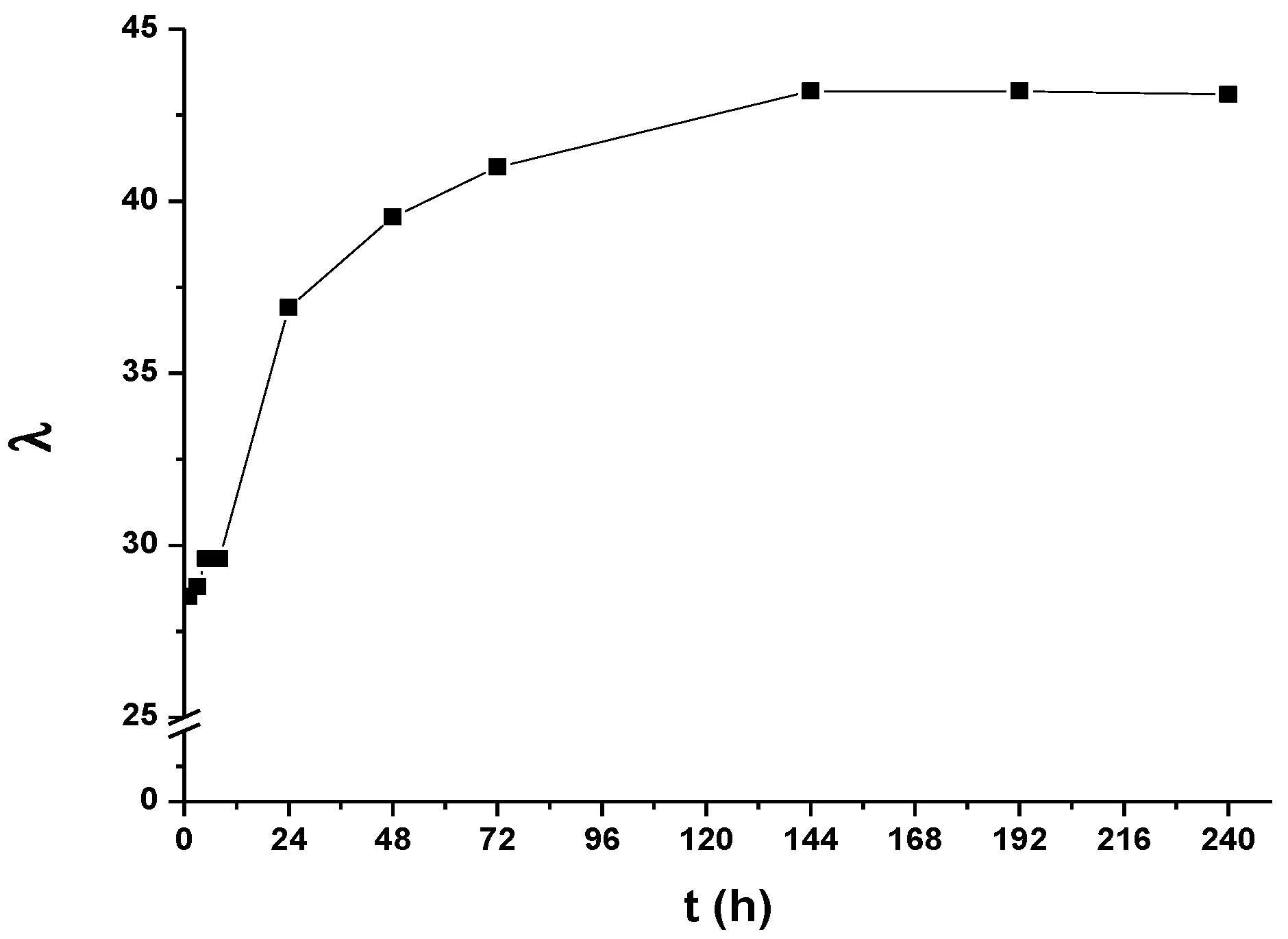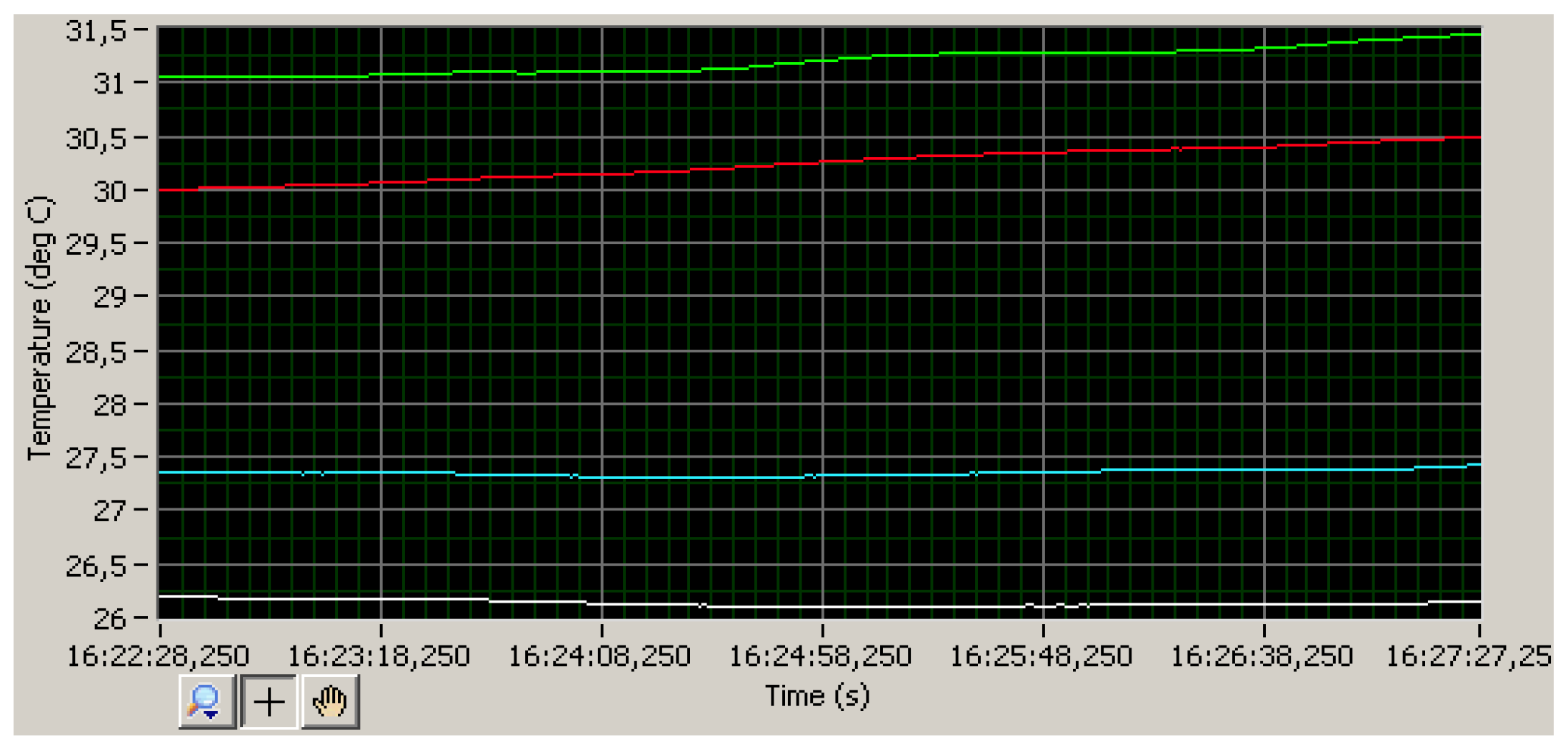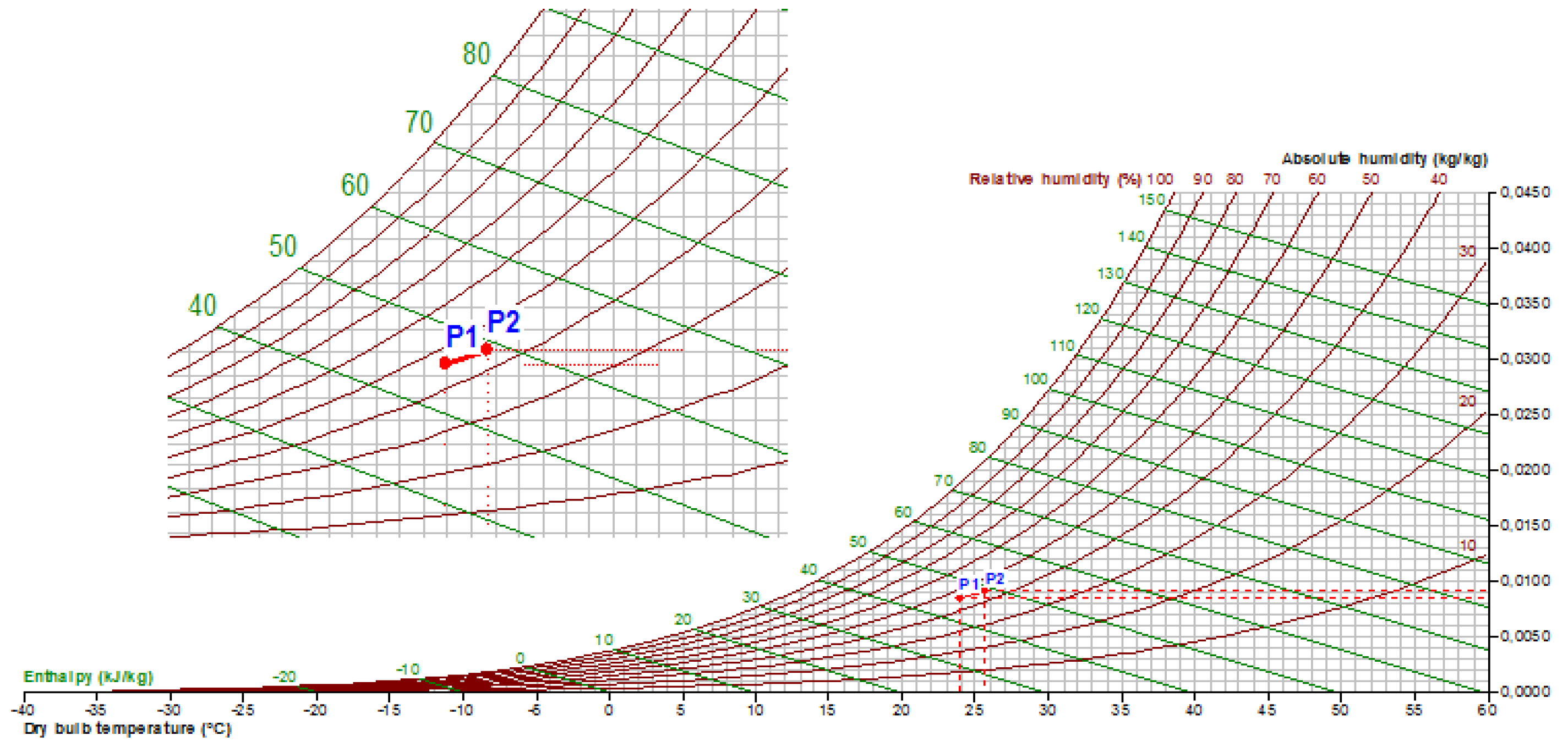Stabilized SPEEK Membranes with a High Degree of Sulfonation for Enthalpy Heat Exchangers
Abstract
:1. Introduction
2. Materials and Methods
2.1. Materials
2.2. Membrane Preparation
2.3. Membrane Characterization
2.3.1. Ion Exchange Capacity Measurements
2.3.2. Water Uptake
2.3.3. Counter-Elastic Pressure (nc) Measurements
2.3.4. Membrane Density, Volume
2.3.5. DMA
2.3.6. Enthalpy Heat Exchanger
3. Results and Discussion
4. Conclusions
5. Patents
Author Contributions
Funding
Conflicts of Interest
References
- Reay, D.A. Heat Recovery Systems; E & F.N. Span: London, UK, 1979. [Google Scholar]
- Fernandez-Seara, J.; Diz, R.; Uhia, F.J.; Dopazo, A.; Ferro, J.M. Experimental analysis of an air-to-air heat recovery unit for balanced ventilation systems in residential buildings. Energy Convers. Manag. 2011, 52, 635–640. [Google Scholar] [CrossRef]
- Al-Waked, R.; Nasif, M.S.; Morrison, G.; Behnia, M. CFD simulation of air to air enthalpy heat exchanger: Variable membrane moisture resistance. Appl. Therm. Eng. 2015, 84, 301–309. [Google Scholar] [CrossRef]
- Woods, J. Membrane processes for heating, ventilation, and air conditioning. Renew. Sustain. Energy Rev. 2014, 33, 290–304. [Google Scholar] [CrossRef]
- Zhang, L.Z.; Liang, C.H.; Pei, L.X. Heat and moisture transfer in application scale parallel-plates enthalpy exchangers with novel membrane materials. J. Membr. Sci. 2008, 325, 672–682. [Google Scholar] [CrossRef]
- Xu, T.W. Ion exchange membranes: State of their development and perspective. J. Membr. Sci. 2005, 263, 1–29. [Google Scholar] [CrossRef]
- Daufin, G.; Escudier, J.P.; Carrere, H.; Berot, S.; Fillaudeau, L.; Decloux, M. Recent and emerging applications of membrane processes in the food and dairy industry. Food Bioprod. Process. 2001, 79, 89–102. [Google Scholar] [CrossRef]
- Tarvainen, T.; Svarfvar, B.; Akerman, S.; Savolainen, J.; Karhu, M.; Paronen, P.; Jarvinen, K. Drug release from a porous ion-exchange membrane in vitro. Biomaterials 1999, 20, 2177–2183. [Google Scholar] [CrossRef]
- Dobbs, G.M.; Freihaut, J.D. Plate-Type Heat Exchanger. U.S. Patent 6684943B2, 3 February 2004. [Google Scholar]
- Dobbs, G.M.; Benoit, J.T.; Lemcoff, N.O. Droplet Actuator Devices and Methods. WO2010/002957 A2, 1 July 2010. [Google Scholar]
- Ehrenberg, S.G.; Huynh, H.; Johnson, B. Enhanced HVAC System and Method. U.S. Patent 8470071, 25 June 2013. [Google Scholar]
- Dean, F.J.; Kadylak, D.E.; Huizing, R.N.; Balanko, J.B.; Mullen, C.W. Counter-Flow Energy Recovery Ventilator (ERV) Core. WO2013/091099 A1, 27 June 2013. [Google Scholar]
- Alberti, G.; Narducci, R.; Di Vona, M.L.; Giancola, S. More on Nafion Conductivity Decay at Temperatures Higher than 80 °C: Preparation and First Characterization of In-Plane Oriented Layered Morphologies. Ind. Eng. Chem. Res. 2013, 52, 10418–10424. [Google Scholar] [CrossRef]
- Alberti, G.; Di Vona, M.L.; Narducci, R. New results on the visco-elastic behaviour of ionomer membranes and relations between T-RH plots and proton conductivity decay of Nafion (R) 117 in the range 50–140 °C. Int. J. Hydrogen Energy 2012, 37, 6302–6307. [Google Scholar] [CrossRef]
- Alberti, G.; Narducci, R.; Di Vona, M.L. Solid State Proton Conductors: Properties and Applications in Fuel Cells; Knauth, P., Di Vona, M.L., Eds.; Wiley: Hoboken, NJ, USA, 2012. [Google Scholar]
- Mauritz, K.A.; Moore, R.B. State of understanding of Nafion. Chem. Rev. 2004, 104, 4535–4585. [Google Scholar] [CrossRef] [PubMed]
- Roberti, E.; Carlotti, G.; Cinelli, S.; Onori, G.; Donnadio, A.; Narducci, R.; Casciola, M.; Sganappa, M. Measurement of the Young’s modulus of Nafion membranes by Brillouin light scattering. J. Power Sources 2010, 195, 7761–7764. [Google Scholar] [CrossRef]
- Yang, H.R.; Zhang, J.; Li, J.L.; Jiang, S.P.; Forsyth, M.; Zhu, H.J. Proton Transport in Hierarchical-Structured Nafion Membranes: A NMR Study. J. Phys. Chem. Lett. 2017, 8, 3624–3629. [Google Scholar] [CrossRef] [PubMed]
- Buck, R.C.; Franklin, J.; Berger, U.; Conder, J.M.; Cousins, I.T.; Voogt, P.D.; Jensen, A.A.; Kannan, K.; Mabury, S.A.; Leeuwen, S.P.V. Perfluoroalkyl and polyfluoroalkyl substances in the environment: terminology, classification, and origins. Integr. Environ. Assess. Manag. 2011, 7, 513–541. [Google Scholar] [CrossRef] [PubMed]
- Identification of Substances of Very High Concern (SVHC) under the ‘Equivalent Level of Concern’ Route (REACH Article 57(f))—Neurotoxicants and Immunotoxicants as Examples; EUR Scientific and Technical Research Reports; Publications Office of the European Union: Rue Mercier, Luxembourg, 2015. [CrossRef]
- Alberti, G.; Narducci, R.; Sganappa, M. Effects of hydrothermal/thermal treatments on the water-uptake of Nafion membranes and relations with changes of conformation, counter-elastic force and tensile modulus of the matrix. J. Power Sources 2008, 178, 575–583. [Google Scholar] [CrossRef]
- Alberti, G.; Narducci, R.; Di Vona, M.L.; Giancola, S. Annealing of Nafion 1100 in the Presence of an Annealing Agent: APowerful Method for Increasing Ionomer Working Temperature in PEMFCs. Fuel Cells 2013, 13, 42–47. [Google Scholar] [CrossRef]
- Potreck, J. Membranes for Flue Gas Treatment. Ph.D. Thesis, University of Twente, Enschede, The Netherlands, 2009. [Google Scholar]
- Sgreccia, E.; Chailan, J.F.; Khadhraoui, M.; Di Vona, M.L.; Knauth, P. Mechanical properties of proton-conducting sulfonated aromatic polymer membranes: Stress-strain tests and dynamical analysis. J. Power Sources 2010, 195, 7770–7775. [Google Scholar] [CrossRef]
- Barbieri, G.; Brunetti, A.; Di Vona, M.L.; Sgreccia, E.; Knauth, P.; Hou, H.Y.; Hempelmann, R.; Arena, F.; Beretta, L.D.; Bauer, B.; et al. LoLiPEM: Long life proton exchange membrane fuel cells. Int. J. Hydrogen Energy 2016, 41, 1921–1934. [Google Scholar] [CrossRef]
- Di Vona, M.L.; Sgreccia, E.; Licoccia, S.; Alberti, G.; Tortet, L.; Knauth, P. Analysis of Temperature-Promoted and Solvent-Assisted Cross-Linking in Sulfonated Poly(ether ether ketone) (SPEEK) Proton-Conducting Membranes. J. Phys. Chem. B 2009, 113, 7505–7512. [Google Scholar] [CrossRef] [PubMed] [Green Version]
- Maranesi, B.; Hou, H.; Polini, R.; Sgreccia, E.; Alberti, G.; Narducci, R.; Knauth, P.; Di Vona, M.L. Cross-Linking of Sulfonated Poly(ether ether ketone) by Thermal Treatment: How Does the Reaction Occur? Fuel Cells 2013, 13, 107–117. [Google Scholar] [CrossRef] [Green Version]
- Rammler, D.H.; Zaffaroni, A. Biological implications of DMSO based on a review of its chemical properties. Ann. N. Y. Acad. Sci. 1967, 141, 13–23. [Google Scholar] [CrossRef] [PubMed]
- Di Vona, M.L.; Pasquini, L.; Narducci, R.; Pelzer, K.; Donnadio, A.; Casciola, M.; Knauth, P. Cross-linked sulfonated aromatic ionomers via SO2 bridges: Conductivity properties. J. Power Sources 2013, 243, 488–493. [Google Scholar] [CrossRef]
- Kerres, J.A. Blended and cross-linked ionomer membranes for application in membrane fuel cells. Fuel Cells 2005, 5, 230–247. [Google Scholar] [CrossRef]
- Kerres, J.A.; Xing, D.M.; Schonberger, F. Comparative investigation of novel PBI blend ionomer membranes from nonfluorinated and partially fluorinated poly arylene ethers. J. Polym. Sci. Part B Polym. Phys. 2006, 44, 2311–2326. [Google Scholar] [CrossRef]
- Bhattacharya, A.; Rawlins, J.W.; Ray, P. Polymer Grafting and Crosslinking; Wiley: Hoboken, NJ, USA, 2008. [Google Scholar]
- Huang, R.Y.M.; Shao, P.H.; Burns, C.M.; Feng, X. Sulfonation of poly(ether ether ketone)(PEEK): Kinetic study and characterization. J. Appl. Polym. Sci. 2001, 82, 2651–2660. [Google Scholar] [CrossRef]
- Shibuya, N.; Porter, R.S. Kinetics of peek sulfonation in concentrated sulfuric-acid. Macromolecules 1992, 25, 6495–6499. [Google Scholar] [CrossRef]
- Deluca, N.W.; Elabd, Y.A. Polymer electrolyte membranes for the direct methanol fuel cell: A review. J. Polym. Sci. Part B Polym. Phys. 2006, 44, 2201–2225. [Google Scholar] [CrossRef]
- Jiang, R.C.; Kunz, H.R.; Fenton, J.M. Investigation of membrane property and fuel cell behavior with sulfonated poly(ether ether ketone) electrolyte: Temperature and relative humidity effects. J. Power Sources 2005, 150, 120–128. [Google Scholar] [CrossRef]
- Astill, T.; Xie, Z.; Shi, Z.Q.; Navessin, T.; Holdcroft, S. Factors Influencing Electrochemical Properties and Performance of Hydrocarbon-Based Electrolyte PEMFC Catalyst Layers. J. Electrochem. Soc. 2009, 156, B499–B508. [Google Scholar] [CrossRef]
- Chen, J.H.; Li, D.R.; Koshikawa, H.; Asano, M.; Maekawa, Y. Crosslinking and grafting of polyetheretherketone film by radiation techniques for application in fuel cells. J. Membr. Sci. 2010, 362, 488–494. [Google Scholar] [CrossRef]
- Fontananova, E.; Brunetti, A.; Trotta, F.; Biasizzo, M.; Drioli, E.; Barbieri, G. Stabilization of Sulfonated Aromatic Polymer (SAP) Membranes Based on SPEEK-WC for PEMFCs. Fuel Cells 2013, 13, 86–97. [Google Scholar] [CrossRef]
- Di Vona, M.L.; Sgreccia, E.; Narducci, R.; Pasquini, L.; Hou, H.; Knauth, P. Stabilized sulfonated aromatic polymers by in situ solvothermal cross-linking. Front. Energy Res. 2014, 2, 39. [Google Scholar] [CrossRef]
- Narducci, R.; Di Vona, M.L.; Knauth, P. Cation-conducting ionomers made by ion exchange of sulfonated poly-ether-ether-ketone: Hydration, mechanical and thermal properties and ionic conductivity. J. Membr. Sci. 2014, 465, 185–192. [Google Scholar] [CrossRef]
- Al Lafi, A.G.; Hay, J.N. State of the water in crosslinked sulfonated poly(ether ether ketone). J. Appl. Polym. Sci. 2013, 128, 3000–3009. [Google Scholar] [CrossRef]
- Arena, F.; Mitzel, J.; Hempelmann, R. Permeability and Diffusivity Measurements on Polymer Electrolyte Membranes. Fuel Cells 2013, 13, 58–64. [Google Scholar] [CrossRef]
- Molla, S.; Compan, V. Polymer blends of SPEEK for DMFC application at intermediate temperatures. Int. J. Hydrogen Energy 2014, 39, 5121–5136. [Google Scholar] [CrossRef]
- Zhao, Y.Y.; Tsuchida, E.; Choe, Y.K.; Ikeshoji, T.; Barique, M.A.; Ohira, A. Ab initio studies on the proton dissociation and infrared spectra of sulfonated poly(ether ether ketone) (SPEEK) membranes. Phys. Chem. Chem. Phys. 2014, 16, 1041–1049. [Google Scholar] [CrossRef] [PubMed]
- Han, S.; Zhang, M.S.; Shin, J.; Lee, Y.S. A Convenient Crosslinking Method for Sulfonated Poly(ether ether ketone) Membranes via Friedel-Crafts Reaction Using 1,6-Dibromohexane and Aluminum Trichloride. J. Appl. Polym. Sci. 2014, 131, 40695. [Google Scholar] [CrossRef]
- Zaidi, S.M.J.; Mikhailenko, S.D.; Robertson, G.P.; Guiver, M.D.; Kaliaguine, S. Proton conducting composite membranes from polyether ether ketone and heteropolyacids for fuel cell applications. J. Membr. Sci. 2000, 173, 17–34. [Google Scholar] [CrossRef]
- Alberti, G.; Narducci, R. Evolution of Permanent Deformations (or Memory) in Nafion 117 Membranes with Changes in Temperature, Relative Humidity and Time, and Its Importance in the Development of Medium Temperature PEMFCs. Fuel Cells 2009, 9, 410–420. [Google Scholar] [CrossRef]
- Alberti, G.; Narducci, R.; Di Vona, M.L.; Giancola, S. Preparation and Nc/T plots of un-crystallized Nafion 1100 and semi-crystalline Nafion 1000. Int. J. Hydrogen Energy 2017, 42, 15908–15912. [Google Scholar] [CrossRef]
- Di Vona, M.L.; Baldinelli, G.; Marrocchi, A.; Narducci, R. Scambiatori di Calore Entalpici a Membrane di Tipo Polimerico Aromatic Solfonato e Procedimento per la Preparazione di Dette Membrane. Domanda numero: 102016000112268. 8 November 2016. (In Italian) [Google Scholar]
- Narducci, R. Ion Conducting Membranes for Fuel Cell. Ph.D. Thesis, University of Rome Tor Vergata, Aix Marseille, Rome, 2014. [Google Scholar]
- Hou, H.Y.; Maranesi, B.; Chailan, J.F.; Khadhraoui, M.; Polini, R.; Di Vona, M.L.; Knauth, P. Crosslinked SPEEK membranes: Mechanical, thermal, and hydrothermal properties. J. Mater. Res. 2012, 27, 1950–1957. [Google Scholar] [CrossRef] [Green Version]
- Knauth, P.; Sgreccia, E.; Di Vona, M.L. Chemomechanics of acidic ionomers: Hydration isotherms and physical model. J. Power Sources 2014, 267, 692–699. [Google Scholar] [CrossRef]

















| Temperature (°C) | WU (%) H2O 24 h (±5%) | λ H2O 24 h (±5%) | nc H2O 24 h (±5%) |
|---|---|---|---|
| 1.5 | 70 | 20 | 7.1 |
| 5 | 85 | 23 | 5.9 |
| 10 | 107 | 29 | 4.2 |
| 15 | 135 | 32 | 3.8 |
| Temperature (°C) | WU (%) H2O 24 h (±5%) | λ H2O 24 h (±5%) | nc H2O 24 h (±5%) |
|---|---|---|---|
| 1 | 50 | 12 | 15.4 |
| 5 | 80 | 20 | 7.1 |
| 10 | 600 | 150 | 0.7 |
| SPEEK | DXL | E/MPa | UTS/MPa | YS/MPa | ε | Tg/°C |
|---|---|---|---|---|---|---|
| 120 °C, 24 h | 0 | 850 ± 60 | 32 ± 1 | 20 ± 2 | 20 ± 8 | 180 |
| 180 °C, 3 h | 0.1 | 1160 ± 50 | 41 ± 2 | 30 ± 2 | 22 ± 9 | 193 |
| 180 °C, 10 h | 0.22 | 1300 ± 100 | 43 ± 8 | 35 ± 5 | 20 ± 12 | 239 |
| 180 °C, 24 h | 0.35 | 1450 ± 50 | 59 ± 2 | 45 ± 2 | 11 ± 1 | >250 |
| Sample | WU (%) (±5%) | λ (±5%) | nc (±5%) | Vwet (mm3) | dwet (g/cm3) | Vdry (mm3) | ddry (g/cm3) (±5%) |
|---|---|---|---|---|---|---|---|
| SPEEK 120–24 (DXL = 0) | ∞ | ∞ | 0 | – | – | 25.4 | 1.35 |
| XL-SPEEK 180–7 H2O 100 °C (DXL = 0.16) | 100 | 25 | 5 | 56.8 | 1.22 | 24.8 | 1.38 |
| DXL = 0 | DXL = 0.1 | DXL = 0.22 | |||
|---|---|---|---|---|---|
| RH (±1%) | WU (±5%) | RH (±1%) | WU (±5%) | RH (±1%) | WU (±5%) |
| 15 | 2 | 15 | 2 | 15 | 2 |
| 40 | 8 | 40 | 7 | 40 | 8 |
| 58 | 10 | 58 | 10 | 58 | 12 |
| 80 | 21 | 80 | 18 | 80 | 23 |
| 97 | 46 | 97 | 36 | 97 | 30 |
© 2018 by the authors. Licensee MDPI, Basel, Switzerland. This article is an open access article distributed under the terms and conditions of the Creative Commons Attribution (CC BY) license (http://creativecommons.org/licenses/by/4.0/).
Share and Cite
Narducci, R.; Di Vona, M.L.; Marrocchi, A.; Baldinelli, G. Stabilized SPEEK Membranes with a High Degree of Sulfonation for Enthalpy Heat Exchangers. Coatings 2018, 8, 190. https://doi.org/10.3390/coatings8050190
Narducci R, Di Vona ML, Marrocchi A, Baldinelli G. Stabilized SPEEK Membranes with a High Degree of Sulfonation for Enthalpy Heat Exchangers. Coatings. 2018; 8(5):190. https://doi.org/10.3390/coatings8050190
Chicago/Turabian StyleNarducci, Riccardo, Maria Luisa Di Vona, Assunta Marrocchi, and Giorgio Baldinelli. 2018. "Stabilized SPEEK Membranes with a High Degree of Sulfonation for Enthalpy Heat Exchangers" Coatings 8, no. 5: 190. https://doi.org/10.3390/coatings8050190







